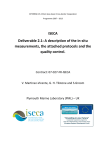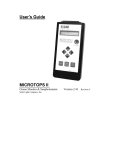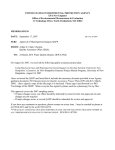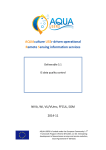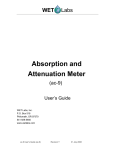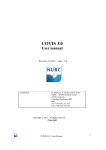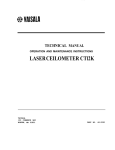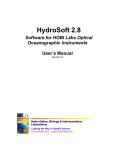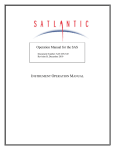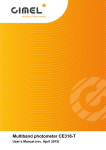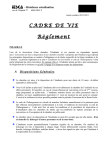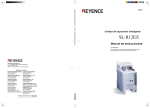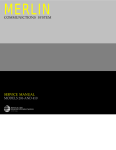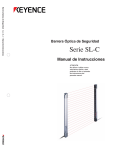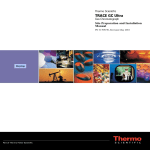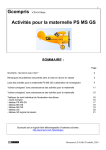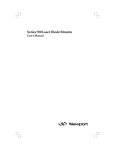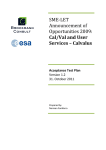Download pdf
Transcript
INTERREG IVA 2 Mers Seas Zeeen Cross-border Cooperation Programme 2007 – 2013 ISECA Protocols for the Validation of Ocean Colour Satellite data in Case 2 European Waters. Contract: 07-027-FR-ISECA G. H. Tilstone and V. Martinez-Vicente, 2012. Plymouth Marine Laboratory (PML) – UK. Based on NASA and ESA protocols IESCA satellite validation protocols 07-027-FR-ISECA 1 INTRODUCTION TO REVAMP PROTOCOLS..................................... 5 Definition ........................................................................................................................ 6 Introduction ..................................................................................................................... 6 Instrument description .................................................................................................... 6 Analytical procedure ....................................................................................................... 7 Instrument Calibration and Quality Assurance ............................................................... 7 Methodology ................................................................................................................... 7 Sample collection and filtration .................................................................................. 7 Sample storage ............................................................................................................ 8 Measurements procedure ............................................................................................ 8 Data processing ............................................................................................................... 9 Pathlength Wavelength Correction, ............................................................................. 9 References ..................................................................................................................... 10 Backscatter coefficient, () (m-1).......................................................... 11 Introduction ................................................................................................................... 11 The Hobilabs instrument ............................................................................................... 11 Instrument description .................................................................................................. 11 Methodology and data quality control .......................................................................... 12 Deployment ............................................................................................................... 12 Windows ................................................................................................................... 12 Precautions and maintenance ........................................................................................ 13 General cleaning ....................................................................................................... 13 Pressure transducer ................................................................................................... 13 Data Processing ............................................................................................................. 13 Calibration coefficients ................................................................................................. 13 Calibration..................................................................................................................... 13 The WETLABS instrument .......................................................................................... 14 Instrument description .................................................................................................. 14 Instrument Calibration and quality assurance ............................................................... 14 Methodology and processing description ..................................................................... 14 Deployment ............................................................................................................... 14 Precautions ................................................................................................................ 14 Upkeep and Maintenance .............................................................................................. 15 Data Processing ......................................................................................................... 15 Attenuation coupling ................................................................................................. 15 References ..................................................................................................................... 15 In situ spectral Beam Attenuation coefficient - c(z,) [m-1], ................... 16 In situ spectral Absorption Coefficient - a(z,) [m-1], ............................. 16 Instrument Calibration and Quality Assurance ............................................................. 16 Mounting and Deployment of the instrument. .......................................................... 16 Field pure water calibration ...................................................................................... 16 Methodology and processing description ..................................................................... 17 Temperature and salinity corrections. ....................................................................... 17 Scattering corrections of the absorption coefficient. ................................................ 18 IESCA satellite validation protocols 07-027-FR-ISECA 2 Primary Quality Checks ............................................................................................ 18 Calibration coefficients ................................................................................................. 18 Limitations .................................................................................................................... 19 References ..................................................................................................................... 19 Coloured dissolved organic material (m-1) ............................................... 20 Definition ...................................................................................................................... 20 Instrumentation ............................................................................................................. 20 Instrument Calibration and quality assurance ............................................................... 20 Filtration and Storage.................................................................................................... 20 Measurement procedure: ............................................................................................... 21 Data Processing ............................................................................................................. 21 References. .................................................................................................................... 21 Pigments Concentration by High Performance Liquid Chromatography [mg m-3 or g l-1]......................................................................................... 23 Instrument description .................................................................................................. 23 Instrument Calibration and Quality Assurance ............................................................. 24 Determination of pigment response factors .............................................................. 24 Methodology and Processing Description. ................................................................... 24 Pigment extraction and sample preparation .............................................................. 25 Analysis program ...................................................................................................... 25 Processing description .............................................................................................. 25 Quality Assurance ..................................................................................................... 26 Sample Storage ............................................................................................................. 26 Limitations .................................................................................................................... 26 References ..................................................................................................................... 26 Surface Downwelling Spectral Irradiance, Es () (W m-2 nm-1) ............. 28 Instrument description .................................................................................................. 28 Instrument Calibration and Quality Assurance ............................................................. 29 Methodology and Processing Description. ................................................................... 29 Deployment of the instrument .................................................................................. 29 Description of processing techniques employed....................................................... 29 Primary Quality Checks ............................................................................................ 30 Primary Processing ................................................................................................... 30 Calibration coefficients ................................................................................................. 30 Limitations .................................................................................................................... 30 References ..................................................................................................................... 30 Spectral Sky Radiance - Lsky() ................................................................ 31 Spectral Direct Sun Irradiance - Esun() .................................................. 31 Instrument description CIMEL 318 Sun Photometer ................................................... 31 Instrument Calibration and Quality Assurance. ............................................................ 32 Methodology and Processing Description. ................................................................... 32 Deployment of the instrument .................................................................................. 32 Methodology for sample collection .......................................................................... 32 Primary quality checks before submission of Level 1 data ...................................... 32 Calibration coefficients ............................................................................................. 33 IESCA satellite validation protocols 07-027-FR-ISECA 3 Limitations .................................................................................................................... 33 References ..................................................................................................................... 33 Total Suspended Matter - TSM (g m-3) .................................................... 34 Instrument description .................................................................................................. 34 Definition ...................................................................................................................... 34 Instrument calibration and quality assurance ................................................................ 34 Methodology ................................................................................................................. 34 Filter preparation ....................................................................................................... 34 Filtration .................................................................................................................... 34 TSM concentration........................................................................................................ 35 Limitations .................................................................................................................... 35 References ..................................................................................................................... 35 Above-water Water Leaving Radiance, Lw (Wm-2nm-1sr-1) and Downwelling Irradiance, Es (W m-2nm-1) ................................................ 36 Instrument Description.................................................................................................. 36 QA and data processing details ..................................................................................... 36 Instrument Calibration and Quality Assurance ............................................................. 37 Methodology and Processing Description .................................................................... 37 Limitations .................................................................................................................... 37 References ..................................................................................................................... 37 Above-water MERIS reflectance, ρw () (dimensionless) – .................... 39 TriOS method............................................................................................. 39 Instrument description .................................................................................................. 39 Instrument Calibration and Quality Assurance ............................................................. 40 Methodology and Processing Description. ................................................................... 40 Deployment of the instrument .................................................................................. 40 Description of processing techniques employed....................................................... 40 Preprocessing Quality Checks .................................................................................. 41 Data Processing ......................................................................................................... 41 Postprocessing Quality Checks ................................................................................. 41 Limitations .................................................................................................................... 41 References ..................................................................................................................... 42 SIMBADA method ..................................................................................... 43 Instrument description .................................................................................................. 43 Instrument Calibration and Quality Assurance ............................................................. 44 Methodology and Processing Description. ................................................................... 44 Deployment of the instrument .................................................................................. 44 Description of processing techniques and quality checks......................................... 44 Limitations .................................................................................................................... 44 References ..................................................................................................................... 44 IESCA satellite validation protocols 07-027-FR-ISECA 4 INTRODUCTION TO ISECA PROTOCOLS In Case 1 waters Chlorophyll a (Chla) determined from Ocean Color is closely related to the absorption of light by phytoplankton pigments. Algorithms based on blue : blue – green reflectance ratios are reliable for the derivation of Chla in these waters. For Case 2 waters where high suspended particulate material (TSM) and coloured dissolved organic material (CDOM) causes a de-coupling of phytoplankton absorption and the underwater light field, accurate retrieval of Chla is far more complex and as yet remains unresolved. Optical and bio-optical protocols have been well documented for Case 1 waters for validating SeaWiFS data (Mueller & Austin 1992, Fargion & Mueller 2000), but require modification for the more complex Case 2 waters and for validating data from more recent sensors such as MODIS and MERIS. Defining the contribution of CDOM, living and non–living matter to the optical properties of the upper water column and the development of reliable and robust methodologies for Case 2 waters is fundamental for remote sensing research. The following protocols document draws on the experience of NASA’s SeaWiFS project and the EU Colors project (Coastal region long-term measurements for colour remote sensing development and validation MAS3 – CT97 – 0087; funded by the EU Marine Science and Technology Programme MAST III Startegic Marine Research) and the EU FP5 project REVAMP (Regional validation of MERIS chlorophyll products in North Sea coastal waters EVG1-CT-2001-00049; Tilstone et al. 2003). The protocols should be used in parallel with Protocols for the Validation of MERIS water products (Doerffer 2002) which documents MERIS water products, validation strategies and sampling criteria. This document builds on MERIS protocols to give more detailed guide lines for the determination of apparent and inherent optical properties of Case 2 waters of the INTERREG 2-Seas area. References Doerffer R. 2002. Protocols for the validation of MERIS water products. European Space Agency Doc. No. PO-TN-MEL-GS-0043. Fargion G.S., Mueller J.L. 2000. Ocean Optics Protocols for Satellite Ocean Colour Sensor Validation, Revision 2. NASA Goddard Space Flight Center, Greenbelt, Maryland, pp 125 – 153. Mueller J.L., Austin R.W. 1992. Ocean Optics Protocols for SeaWiFS Validation. SeaWiFS Technical Report Series. NASA Tech. Memo. 104566. Tilstone GH, Moore GF, Sorensen K, Doerffer R, Rottgers R, Ruddick KG, Pasterkamp R. (2003). Protocols for the validation of MERIS products in Case 2 waters. Proceedings from ENVISAT MAVT Conference, 20 - 24 October 2003, Frascatti, Italy. European Space Agency. http://envisat.esa.int/workshops/mavt_2003/MAVT2003_802_REVAMPprotocols3.pdf IESCA satellite validation protocols 07-027-FR-ISECA 5 In-vivo Absorption Spectra of pigmented and non pigmented Particulate Matter - apm() (m-1) Definition The light transmission of aquatic particles retained on filter. Introduction The light transmission measurement of aquatic particles retained on a filter is considered a standard method for the determination of the in vivo particle absorption. The analysis consists of measuring the fraction of a light beam passing through particles retained on a filter to derive the absorbance Apm() on the filter and is then transformed to give the equivalent absorption coefficient apm() [m-1] in suspension. Instrument description A dual beam spectrophotometer provided with a Spectralon® coated (barium sulphate degrades with seawater) integrating-sphere attachment, is ideal. In dual beam instruments, the correction for the difference in the beam efficiencies is automatically performed (Tassan and Ferrari, 1995). Single beam instruments are not recommended, as it is difficult to characterize the baseline and spectral performance of the instrument (Mitchell et al. 2000). Before sample measurements are performed, baseline and spectral noise should be well documented using air – air scans to check instrument performance, each time the spectrophotometer is switched on. Measurements are performed in the spectral range 350-800 nm with a 1nm resolution. The instrument photometric accuracy should be at least ±0.003A or ±0.08%T at 1A; ±0.002A or ±0.05%T at 0.05 A, measured with NBS 930 filters, (Perkin Elmer Lambda specifications). Systems with variable slit widths are preferred from 4 nm to below 4 nm. A NASA workshop recommended the use of Cary 100 (Mitchell et al. 2000) and EU FP5 REVAMP workshop showed that the Perkin Elmer range of spectrophotometers (higher than Lambda 800; Fig 1) also shows quality optical performance comparable to the Cary range. Figure 1; Perkin Elmer Lambda 800 spectrophotometer. IESCA satellite validation protocols 07-027-FR-ISECA 6 Recommended baseline noise from 350 to 800 nm for GF/F’s is ± 0.005 A and for 10 cm quartz cuvettes with purified water is ± 0.0005 A. Analytical procedure Warm up the spectrophotometer for at least 30 minutes (Check the specific instrument ‘warm up’ guidelines to meet photometric and baseline accuracy). If samples and blank are frozen, place in petri dish on filtered water to ensure hydration and allow to thaw for at least 5 minutes. Store in a refrigerator until analysis. Both sample and blank filters will dry out over time and must be re-hydrated regularly after every measurement. If the absorbance signal deviates greater than 0.02 absorbance from zero between 750-800 nm, this indicates a drying of the sample (Mitchell et al. 2000). Instrument Calibration and Quality Assurance Spectra should be visually and/or automatically checked, in particular for: The presence of a significant peak around 665 nm in adp() spectra, which indicates non complete bleaching of the sample. abnormal (< 1) ratio of aph(443)/aph(665). Methodology Sample collection and filtration Filtration volume should be adjusted to keep the samples in the optical density range that is ideal for the path length amplification corrections (see below). After collection water samples are transferred to black polyethylene bottles. The samples are immediately filtered through 25 mm GF/F filters (nominal pore size 0.7m). The goals for filtration of particulate samples are to minimize contamination and particle degradation, maximize retention, and concentrate an adequate amount of particles on the filters to permit accurate spectrophotometric measurements (Muller and Austin, 1995). The filtration procedure should therefore be performed as follows: Rinse the filtration equipment with distilled water. Filter a convenient volume of seawater (500-2000ml). The filtration should be carried under low vacuum pressure (below 120mmHg) to prevent particle breakage and pigment degradation. One pair of blank filters for each sample date should be prepared for the subsequent analysis. The blank consists of filters through which 0.22 m pre-filtered seawater has been passed. The pre-filtered seawater volume should match or be similar to the sample volume. Ensure that for both sample and blank GF/F filters that the same side of the filter is used. For GFF filters there is a striated and smooth side to the filter. The striated shows more scattering than the smooth side and if the sample and blank side are not IESCA satellite validation protocols 07-027-FR-ISECA 7 equally matched then differences in compensation between sample and blank may arise (See Appendix A; pp. 61 – 63). Sample storage Optical density spectra of the sample filters should be measured as soon after filtering as possible. If samples are to be run more than 24 hrs after collection, then samples should be flash frozen and stored in flat containers (e.g. petri dishes, petri slides) in liquid nitrogen. Dry shippers are favored for the transportation of samples but dry ice will suffice for short distances (< 36 hr duration). For further details on sample storage see section on HPLC (p) . Measurements procedure The methodology is described in Tassan and Ferrari (1995) with the following modifications: The “Autozero” of the instrument should be made with free entrance ports, using high-grade perfectly balanced reflecting plates on the exit ports; these can be replaced by standard spectralon plates for the following measurements. Performing the “Autozero” with filters on the entrance ports is not considered a good practice because of the difference that may occur in filter transmittances. Baseline flatness using integrating sphere should be at least ±0.004 A units. Depigmentation using NaClO is recommended. Bleaching by Methanol is not advised as phycobilins and eukaryotic pigments are not extracted and some loss of the sample can occur. The bleaching concentration of NaClO can be 1 % active chlorine (Tassan & Ferrari 1995) or 0.1% active chlorine (Tassan et al. 2000). The choice of active chlorine solution depends on the dominant particles or species in the sample. If the sample has a high detritus content, 0.1 % active chlorine is recommended since a 1 % active chloride solution may cause excessive bleaching of the detrital fraction which would result in higher phytoplankton absorption coefficients. If a 1 % solution is used the NaClO can be applied to the filter as 4 to 5 drops as described in Tassan and Ferrari (1995) and ensure that the NaClO spreads over the whole of the filtration area. If 0.1% active chlorine NaClO is used, the sample filter should be placed on the filtration port and stood in 5 ml of NaClO for up to 15 mins. Disappearance of the peak at 675 nm in the bleached sample and evidence of a concave shape of the OD spectrum near to 440 nm can be considered evidence of complete filter bleaching (Mitchell et al. 2000). For both 0.1 & 1 % active chlorine treatment, 5 ml of MilliQ should be re-filtered through the treated GFF filter to remove any residual NaClO (Tassan et al. 2000). Blank filters should also be bleached and re-filtered using the same procedure. Ensure that both sample and blank filters do not dry out. Dry filters, adversely affect the optical density of the sample. IESCA satellite validation protocols 07-027-FR-ISECA 8 Data processing In Case I waters a zero offset from the baseline may occur which is presumed to be the product of scattering throughout spectrum. Hence a spectral region is identified where phytoplankton absorption is assumed to be negligible (typically 750 to 800nm) and the scattering observed is due to non-phytoplankton material. However, in Case 2 waters scattering by particles 750 nm is not negligible since scattering and absorption by detritus increase with decreasing wavelength (Tassan & Ferrari 1995). The experimental and data processing methods of Tassan and Ferrari (1995; equations 11 to 14) are recommended with some modifications to convert the measured absorbance of the filterretained particles into the equivalent particle suspension absorption. Four measurements are therefore required for each sample (two transmission and two reflectance). The instrument baseline for the integrating sphere should be recorded. The data is processed by fitting the detrital curve to an exponential with an offset which takes into consideration the baseline. The particulate absorbance spectra is scaled to the exponent of the detrital curve. is defined as the ratio of (1- Tsd)/(1-Tsp) where Tsd is the transmission of diffuse light through the filter and Tsp is the transmission of parallel light. The following routine is used to calculate : 1.171 0.2615 0.00013 (Equation 1) where is the absorption in transmission mode either of the pigmented or de-pigmented sample given as follows: 1 log10 (Equation 2) st where st is the sample transmission. The wavelength specific absorption coefficient is calculated from the absorbance of the material in suspension (Asus): A ( ) a 2.3 sus XC (Equation 3) where X is the ratio of the filtered volume to the filter clearance area and C is the particle concentration. Absorbance of the material retained on the filter is converted to absorbance of the material in suspension using a pathlength wavelength correction factor (see below). Pathlength Wavelength Correction, The amount of sample filtered should yield an optical density at 675 nm of between 0.05 & 0.25 A and with a blue absorption 0.4 A. High suspension absorbance leads to increasing errors when applying (Mitchell et al. 2000). Few values have been reported for Case 2 waters (Tassan & Ferrari 1998). For the purpose of data storage, is set equal to 2 (Roesler 1998), which is based on the assumption that for GF/F filters the diffuse absorption of a sample is twice the volume of absorption coefficient. IESCA satellite validation protocols 07-027-FR-ISECA 9 Specific correction should be calculated for specific areas and phytoplankton assemblages and the method of correction should be recorded. Accuracy. The overall error of the filter-retained optical particle optical density is 0.002 with an error of 0.015 associated with the variability in physical properties of the GF/F filter. The corresponding error of the optical density of suspended particles showed that the error increased with increasing optical density from 0.0015 at an OD of 0.05 to 0.027 at 0.59 OD. Whilst the T-R method detritus rich coastal waters, in mineral laden waters Tassan and Ferrari (2002) reported that the light scattering term used in the determination of transmittance, may cause errors in the measured optical density spectra of mineral particles. They therefore revised the methods by conducting the ‘transmission and reference measurements’ not referenced to a blank filter, then measuring the optical transmission of the blank filter separately in the same way (Tassan and Ferrari, 2002). References Mitchell GB, Bricaud A, Carder K, Cleveland J, Ferrari G, Gould R, Kahru M, Kishino M, Maske H, Moisan T, Moore L, Nelson N, Phimney D, Reynodls R, Sosik H, Stramski D, Tassan S, Trees C, Weideman A, Wieland J, Vodacek A. 2000. Determination of spectral absorption coefficients of particles, dissolved material and phytoplankton for discrete water samples. NASA Tech. Memo. 209966. in GS Fargion and JL Mueller Eds. Ocean Optics Protocols for Satellite Ocean Colour Sensor Validation, Revision 2. NASA Goddard Space Flight Center, Greenbelt, Maryland, pp 125 – 153. Mueller, J.L., and R.W. Austin. 1995: Ocean Optics Protocols for SeaWiFS Validation, Revision 1. NASA Tech. Memo. 104566, Vol.25, S.B. Hooker and E.R.Firestone, Eds, NASA Goddard Space Flight Center, Greenbelt, Maryland, 67pp. Roesler CS. Theoretical and experimental approaches to improve the accuracy of particulate absorption coefficients derived from the quantitative filter technique. 43, 1649-1660. 1998. Tassan, S., and G.M. Ferrari. 1995. An alternative approach to absorption measurements of aquatic particles retained on filters. Limnol. Oceanogr. 40: 1358-1368. Tassan S., and G.M. Ferrari, 1998. Measurement of light absorption by aquatic particles retained on filters: determination of the optical pathlength amplification by the ‘transmittance-reflectance’ method. J Plankt Res. 20: 1699-1709. Tassan S, Ferrari GM, Bricaud A, Babin M 2000. Variability of the amplification factor of light absorption by filter-retained aquatic particles in the coastal environment. Journal of Plankton Res (22) 659-668. Tassan S., and G.M. Ferrari, 2002. A sensitivity analysis of the TransmittanceReflectance’ method for measuring light absorption by aquatic particles. J Plankt Res. 24: 757-774. IESCA satellite validation protocols 07-027-FR-ISECA 10 Backscatter coefficient, () (m-1) Introduction Few historic data exist on the variation in shape of the volume scattering function () in the backward direction. The most widely published data are those of Petzold (1972) and Balch et al .(1994), who used a general angle scattering meter (Mueller et al 2000) to measure () for marine hydrosols. Recent studies have shown, however, that a relationship between the measurement of the volume scattering function in one angle and the total backscattering coefficient exists and can be simplified with the use of a constant value (Boss and Pegau, 2001). Several values for the different angles of measurement have been proposed (Maffione and Dana, 1992; Boss and Pegau, 2001). In-situ studies have shown that the different instruments compare well with measurements of the whole volume scattering function (Berthon et al.2007) More recently several commercial backscatter meters have been developed and are available from Hobilabs and WETLABS. The HydroScat-6 manufactured by Hobilabs measures scattering at centroid angle of 140 and at many fixed wavelengths. The ECO VSF 3 manufactured by WETLABS, measures () at single wavelengths (450, 530, 650 nm), but at three centroid scattering angles (100, 120, 150). Both of these instruments will be utilized during the ISECA contract. These sensors measure a weighted integral of radiance scattered from a working volume defined by the intersection of illumination source beam and angular field of view of the detector (Mueller et al. 2000). The backscattering coefficient (m-1) is calculated from: bb ( ) 2 ( , ) sin d /2 The Hobilabs instrument The following information has been taken from Hydroscat 8 Manual (2010). Instrument description The Hobilabs Hydroscat-6 is a hyperspectral instrument (Fig 2), that measures () at six wavelengths and at 140. It also makes auxiliary measurements of fluorescence. The beam from the LED goes through a lens to adjust its divergence, then through a prism that bends the beam before it enters the water. IESCA satellite validation protocols 07-027-FR-ISECA 11 Figure 2; Hobilabs, Hydroscat Multispectral backscattering meter. – 6; The HydroScat-6 has six independent channels, each sensitive to a different narrow range of optical wavelengths. Hobilabs will configure the instrument to 3 wavelength pairs. For the REVAMP project the following wave bands have been selected; 420, 442, 488, 550, 671, 850, plus fluorescence excited by 442 and emitted to 671. The source produces a beam of light in the water, and the detector collects a portion of the light that is scattered out of that beam by the water. Each source beam originates from a light-emitting diode (LED) selected to match the desired measurement l h Methodology and data quality control Deployment The HydroScat can be suspended vertically from the metal eye on the connector endcap, or strapped to another support. If mounting it to another structure, the finish on the case should be , protected from direct metal contact. To ensure that the HydroScat does not detect reflections from any other objects, It is best to keep a clear 30 cone in front of the detection windows for at least 1 meter. Even objects that appear very non-reflective, or are well out of the nominal sampling volume, can create substantial offsets in the backscattering measurement. The operator should manually check that readings are not unnecessarily elevated by interference from other reflective objects. The sensor should normally face directly down in the water, to minimize the effect of background illumination. However in shallow water over a reflective bottom and under bright solar illumination, light reflected into the windows may cause high noise levels or, in extreme cases, saturation. In such situations it may be advantageous to mount the sensor horizontally so that the backscattering receivers do not face the bottom. Windows HydroScats have acrylic windows that are easily scratched. Minor scratches will not seriously compromise the measurements, but the windows must be treated carefully to avoid abrasion. Do not use acetone or abrasive cleaners. Do not over-clean the windows. Unless the windows become visibly dirty during use, it is usually sufficient to clean them once daily with soap or alcohol and a soft cloth, then rinse them with clean water whenever they are removed from the water. IESCA satellite validation protocols 07-027-FR-ISECA 12 Precautions and maintenance The instrument windows should always be protected. Ensure that the instrument face is covered whenever the instrument is not in use. Do not use acetone to clean any part of the instrument. Thoroughly clean the HydroScat with fresh water before storing it. Avoid letting the sensor sit in direct sunlight on deck. If the water temperature is very different from the temperature on deck, let the instrument stabilize in the water for 10 minutes before collecting data. General cleaning After deploying the instrument, rinse it thoroughly with fresh water, and rinse the windows with distilled or deionized water. The windows should be periodically inspected for contamination. Pressure transducer If your HydroScat-6 is equipped with an oil-filled pressure reservoir and capillary tube, check the tube occasionally to see that it contains oil. It need not be completely full, but the oil meniscus should be visible. For the HydroScat-6 without oil reservoirs, the pressure transducer is located under a black plastic cap, flush with the rear endcap, with four small drain holes. Rinse the sensor with fresh water by gently spraying it into the drain holes. Data Processing The HydroScat software HydroSoft allows you to save calibrated data automatically at the time you collect or download data. Raw data files can also be processed by converting raw hexadecimal data to decimal form without calibrating them. An IDL program has been designed in PML to implement the sigma correction, that takes into account the effect of the attenuation of the backscattered light from the particle. This includes the use of absorption in-situ and attenuation from a Wetlabs ac9 deployed simultaneously to the Hobilabs Hydroscat-6. Calibration coefficients HydroScat data are transmitted in a partially-processed hexadecimal form, which must be converted to calibrated units. The coefficients required for this conversion are unique to each instrument, and may be revised from time to time when the instrument is recalibrated. HydroSoft requires an appropriate calibration to be loaded before it can plot or store calibrated data from an instrument or raw data file. Calibration The weighting function can be measured by moving a spectralon reflective target through the working volume (Maffione and Dana 1997). IESCA satellite validation protocols 07-027-FR-ISECA 13 The WETLABS instrument Instrument description The ECO-VSF 3 measures the optical scattering at three distinct angles: 100, 125, and 150 degrees, at three wavelengths, thus providing the shape of the Volume Scattering Function (VSF) throughout its angular domain. the three-angle measurement allows determination of specific angles of backscattering through interpolation. Conversely, it also can provide the total backscattering coefficient by integration and extrapolation from 90 to 180 degrees using a 3rd order polynomial according to the VSF manual. Figure 3.The ECO – VSF 3 backscattering meter. The optics include three sets of three LED-based transmitters that couple to three receivers. The transmitters and receiver are located to establish centroid light scattering angles of approximately 100, 125, and 150 degrees respectively. For each angle the region of intersection encompasses a full width half maximum (FWHM) bandwidth of about 18 degrees. Each sensor head operates at one wavelength. Presently there are three wavelengths available; 450 nm, 530 nm, and 650 nm. Instrument Calibration and quality assurance Calibration of the ECO-VSF involves the determination of angular coefficients through direct measurement of suspensions of NIST traceable standard spherical beads, which are serially diluted. The dilutions are extrapolated to zero, hence the VSF calibration does not include the angular scattering of pure water. Methodology and processing description Deployment The ECO-VSF 3 requires no pumps to assure successful operation. Once power is supplied, the unit is ready for submersion and subsequent measurements. The sensor faces should not be pointed directly into the sun or other bright lights. Precautions When lowering the instrument, ensure that the mounting brackets are not damaging the unit casing. Avoid obstructing the sensors’ optical paths. The sensor will detect an object directly in front of its optics. IESCA satellite validation protocols 07-027-FR-ISECA 14 Upkeep and Maintenance After each cast or exposure of the instrument to natural water, flush the instrument with clean fresh water, paying careful attention to the sensor face. Use soapy water to cut any grease or oil accumulation. Gently wipe clean with a soft cloth. The sensor face is composed of ABS plastic and optical epoxy and can easily be damaged or scratched. Do not use acetone or other solvents to clean the sensor. At the end of an experiment, the instrument should be rinsed thoroughly, air-dried and stored in a cool, dry place. Data Processing ECO Host will convert raw data obtained during a deployment to processed data, alternatively the output is in a simple ASCII format that may be processed by a spreadsheet. Attenuation coupling Many scattering sensors require a subsequent attenuation correction for pathlength coupling of the transmitted and scattered light. This is typically a function of the propagation distances of the light as well as the magnitude of the water attenuation. Because the ECO-VSF 3 incorporates very short pathlengths and scattering volumes in its measurements, it is relatively immune to this pathlength coupling (Figure 7). For attenuation coefficients up to approximately 5 m-1 no data correction is required. If you are operating the meter in waters with greater turbidity, a different configuration is required. Determination of primary angular coefficients The primary angular coefficients for each angle of backscattering can be applied upon raw data downloaded from the instruments. Determination is made by subtracting the clean water offset from the measured value and multiplying the result by the scaling factors provided in the calibration sheet. References Boss, E., Pegau, W. S.1997.Relationship of light scattering at an angle in the backward direction to the backscattering coefficient. Applied Optics, 40(30):5503–5507, 2001. Maffione R.A., Dana, D.R. 1997. Instruments and methods for measuring the backward scattering coefficient of ocean water.Applied Optics, 36: 6057-6067. Mueller, J.L. 2000.Instrument specifications, characterization and calibration overview. Petzold, T.J., 1972. Volume scattering functions for selected natural waters, Scripps Institution of Oceanography, Visibility Laboratory, San Diego, CA, SIO Ref. 71–78. HydroScat-6 Spectral backscattering sensor USER’S MANUAL .2010., Rev. J , edited, p. 42, HOBILabs Inc. Berthon, J. F., et al. 2007., Measurements and modeling of the volume scattering function in the coastal northern Adriatic Sea, Applied Optics, 46, 5189-5203. IESCA satellite validation protocols 07-027-FR-ISECA 15 In situ spectral Beam Attenuation coefficient - c(z,) [m-1], In situ spectral Absorption Coefficient - a(z,) [m-1], Both at wavelengths412, 440, 488, 510, 555, 630, 650, 676, 715 nm. Instrument Description AC9 - Dual Path Absorption and Attenuation Meter (WET Labs Inc., USA). The ac-9 concurrently determines the spectral beam attenuation and spectral absorption of water over nine wavelengths. Optical Specifications: - Bandpass: 10 nm/channel - Pathlength: 25 cm - Beam cross section diameter: 8 mm - Receiver Acceptance Angle: 0.7 deg (in water) Fig. 4: AC-9 unit (WETlabsInc, USA) Instrument Calibration and Quality Assurance The protocol proposed by Wet Labs (ac9 Protocol document, Revision B) is followed. The salient points regarding deployment and calibration are highlighted below: Mounting and Deployment of the instrument. The instrument is deployed, preferably upright, on a frame lowered into the sea by means of a winch. A small pump brings the water through the ac9 flow tubes (flow rate through the tubes should be kept above 1 liter/minute). All tubing is black or covered with black tape (at least the 20 cm at the flow inlet and outlet) to avoid direct light into the tubes. The lowering speed, for a frequency of acquisition of 6Hz, should be about 0.1-0.2 m s-1. Air bubbles passing through or even remaining trapped into the flow tubes when the instrument is at surface and/or in the first meters (according to sea state), can affect measurements and induce differences between down- and up-cast values profiles. Assuming that putting the instrument at depth (at least 10 meters) may help purging the system for bubbles only the up-cast profiles are considered here. Simultaneous profiles of in situ temperature and salinity are collected for post-correcting the data (see 4. Data Post-Processing). Field pure water calibration The instrument must regularly (once per day of measurement, if possible) be calibrated in the field with pure water (milli-Q water is recommended), in its deployment configuration, in order to remove the effects of small misalignments of the optical system and/or to track possible long-term drift. See also the air calibration procedure in WetLabs protocol. The calibration is performed by making milli-Q water pass through IESCA satellite validation protocols 07-027-FR-ISECA 16 the flow tubes (gravimetrically or by pressurizing the tank) and measuring the resulting offsets. Calibration can simultaneously be done for both a andc (pressurizing the tank is then recommended) or for each one successively. Milli-Q water is stocked into a clean tank (polycarbonate carboy for example) at least 12h before the measurement to allow for degassing. Water can be checked for particles by pointing a helium-neon laser through a glass beaker (in the dark) and looking for light flashes that indicate particles (big flashes) or air bubbles (small flashes). Again, all tubing must be black or covered with black tape (at least the 20 cm at the flow inlet and outlet). The instrument (flow tubes and optical windows) is cleaned using soap water and methanol. Water temperature must be recorded, several times during the calibration if necessary, for post-correction (see 4. Data Post-Processing). Measurements are taken for about 30 seconds with the WETVIEW software: the measured offset must be stable (within 0.005) for each wavelength. Average a portion of (stable) data. Such a sequence is repeated 2 times (opening and cleaning the instrument each time) and the measured offsets must not differ by more than 0.005. In particular, during the calibration one has to check for bubbles that can induce large spikes in the data recorded. After correction for temperature effect (see 4. Data Post-Processing) the resulting mean offsets are averaged and subtracted from the in situ measurements (corrected for temperature, salinity and scattering). Methodology and processing description Temperature and salinity corrections. After collection, raw data must be corrected for the in situ temperature and salinity effects (to correct for differences between the absorption coefficient of the optically pure water used as a reference when calibrating the instrument and the absorption coefficient of the water in which the measurements are performed). These effects are removed by applying to the measured cm() and am(), the following algorithms: cmts()=cm() – [t()(T-Tcal) + sc()(S-Scal)] (1) amts()=am() – [t()(T-Tcal) + sa()(S-Scal)] (2) Where T and S are the temperature and salinity of the water during measurement, respectively, and Tcal and Scal are the temperature and salinity (in principle = 0) of the water during calibration, respectively. The t and s coefficients used are the following (WetLabs ac9 Protocol Document, Revision Q, April 2011) for c and a. IESCA satellite validation protocols 07-027-FR-ISECA 17 Scattering corrections of the absorption coefficient. The portion of the scattered light not collected by the reflecting tube absorption meter causes the instrument to overestimate the absorption coefficient. Presently, three methods mainly are available in order to perform a correction of the measured absorption, with methods #2 and #3 implying that c() be measured simultaneously with a(): #1) amtsb()= amts()-amts(715), (3) by assuming no absorption at 715 nm and no spectral dependence of scattering. #2) amtsb()= amts()-[cmts()-amts()], (4) by assuming the error as a constant proportion of scattering. Typically, =0.14 but can vary between 0.08 (phytoplankton dominated) and 0.3 (sediment dominated). #3) amtsb()=amts() – ( [cmts()-amts()][amts(715)]/[cmts(715)-amts(715)] ) (5) by using a reference wavelength (715 nm) to determine the proportion of scattering and also assuming no absorption at this wavelength. Although method #3 is reputed the most accurate and used as default here, the data provider is let free to propose the most appropriate method for his site. Primary Quality Checks Quality checks are performed after temperature, salinity and scattering corrections and when depth-binning the data (level 2), results are written in the log file. In particular, the following criteria must be respected: - cmtsb() amtsb() 0 ; - number of points within the binning layer (1 meter per default) > 1 ; - depth centroid of data comprised within a layer < 25 % of the binning layer nominal central depth. Calibration coefficients The calibration coefficients adopted are: Coe0=c Coe1=kt IESCA satellite validation protocols 07-027-FR-ISECA 18 Limitations The use of deployment speeds higher than 0.3 m s-1 may reduce the possibility of resolving the vertical structures in water. The presence of air bubbles in the measurement “chambers” may irreparably affect measurements. References Home Page of Oregon State University, College of Oceanic and Atmospheric Sciences, Environmental Optics –1999: http://photon.oce.orst.edu/ocean/instruments/ac9/ac9.html. Pegau W. S. and J. R. V. Zaneveld."Temperature dependent absorption of water in the red and near infrared portions of the spectrum", Limnol.Oceanogr.38, 188-192 (1993). Twardowski M. S., J. M. Sullivan, P. L. Donaghay and J. R. Zaneveld. 1999. Microscale quantification of the absorption by dissolved and particulate material in coastal waters with an ac-9. Journal of Atmospheric and Oceanic Technology, 16:691-707. WET Labs. 2011. ac-9 Protocol Document, Revision Q, 10 April 2011. Zaneveld, J. R. V., J. C. Kitchen, A. Bricaud and C. Moore. 1992. "Analysis of in situ spectral absorption meter data." Ocean Optics XI, G. D. Gilbert, Ed., Proc. SPIE 1750, 187-200. Zaneveld, J. R. V., J. C. Kitchen, and C. C. Moore. 1994. "Scattering error correction of reflecting tube absorption meters." Ocean Optics XII, S.Ackleson, Ed., Proc. SPIE Vol. 2258, 44-55. IESCA satellite validation protocols 07-027-FR-ISECA 19 Coloured dissolved organic material (m-1) Also known as Yellow substance, Chromophoric dissolved organic material, Gelbstoff. Definition Coloured dissolved organic material is defined as the fraction of organic matter which passes through 0.22 m pore size filter. Instrumentation See section on In-vivo Absorption Spectra of pigmented and non pigmented Particulate Matter (p 4.). Instrument Calibration and quality assurance Spectra are visually checked for high background such as high absorption values in the red part of the spectra and abnormal slopes. Pure water such as Millipor, MilliQ, Alpha Q and Barnstead Nanopore is recommended. Ensure when carrying out optical density measurements of CDOM at sea that this water is available otherwise preparation of pure water prior to field work is recommended. The response of the spectrophotometer should be verified with Holmium Oxide filters especially at 412 & 443 nm. Filtration and Storage It is essential to minimize contamination of the samples by organic materials and the samples should be protected from light to reduce sample degradation. Wash hands with soap and water to avoid contamination of samples. Use 0.2 m polycarbonate filters (Whatman Nucleopore are recommended). Filtration apparatus all glass (a funnel, flask and borosilicate filter support) and clenching aluminium pliers. Individual vacuum control of each sample (for accurate pressure regulation) and direct filtration to clean bottles is required. Mount filters on funnel and filter 100 mls of purified water through filter and discard water. Sea water should be collected into all glass brown bottles direct from Niskin bottles or equivalent. Pre-wash dark bottle three times with seawater and collect 200 ml of seawater. Blank preparation. Filter 75 ml of MilliQ or bi-distilled water into glass storage bottle and discard the filtrate. Filter a further 75 ml of pure water for use as blank. Sample preparation. Filter 75 ml of sample into clean bottles at a vacuum pressure of 120 mm Hg. Shake bottles and discard water. Repeat. Filter at least 250 ml of seawater into glass bottles. Cap the bottles and store in the dark. Sample Storage. Samples can be stored for up to 4 hrs at room temperature before being analyzed. Samples can be stored 4 to 24 hrs in a refrigerator (Mitchell et al. 2000). For longer storage, 0.5 ml solution of 10g/l of NaN3 per 100 ml of sample (Ferrari et al 1996) can be added to prevent degradation of IESCA satellite validation protocols 07-027-FR-ISECA 20 CDOM and sample bottles should be kept upright in a refrigerator (4C). However, NaN3 adds to the absorption of the sample. It is recommended that CDOM samples should be run fresh whenever possible. If NaN3 is added for prolonged storage, the sample should be flagged in the meta data base. Measurement procedure: If samples have been refrigerated allow them to warm up so that sample and blank are at the same temperature before scanning the samples. Temperature differences between reference water and sample can lead to strong spectral absorption features (Pegau & Zaneveld 1993). Temperature of reference and sample should be recorded for each measurement. Inspect the cuvettes. Cuvette should be cleaned with MilliQ and lint free wipes. If surface contamination still persists, soak overnight in 10 % HCl and clean with copious amounts of MilliQ. Allow the spectrophotometer to warm up for 30 mins. Confirm that the optical windows are clean. If necessary clean with MilliQ, followed by ethanol HPLC grade, and dry thoroughly with a lint free laboratory tissue. The instrument scan speed should be 120 and slit width, 4. Run an air vs air baseline. Record the baseline. The baseline should be spectrally flat, with < 0.0005 A units. Place one empty cuvette in the spectrophotometer and scan relative to air. Perform an autozero from 350 to 800nm as follows; place a cuvette filled with MilliQ water in the sample cell and nothing in the reference cell. Record the spectrum. Discard the MilliQ from the cuvette and rinse it three times with 5 to 10 ml of the next sample. Then fill the cuvette with the sample and repeat the scan. Run a MilliQ scan between every sample to check the stability of the instrument. Data Processing The MilliQ spectra is subtracted from the sample spectra. No scattering offset correction should be performed. The spectral absorption coefficient of dissolved organic matter is calculated from the measured absorbance as follows: Ays () = 2.303 Ays () / l Where l is the cuvette pathlength. References. Mitchell GB, Bricaud A, Carder K, Cleveland J, Ferrari G, Gould R, Kahru M, Kishino M, Maske H, Moisan T, Moore L, Nelson N, Phimney D, Reynodls R, Sosik H, Stramski D, Tassan S, Trees C, Weideman A, Wieland J, Vodacek A. 2000. Determination of spectral absorption coefficients of particles, dissolved material and phytoplankton for discrete water samples. NASA Tech. Memo. 209966. in GS Fargion and JL Mueller Eds. Ocean Optics Protocols for Satellite Ocean Colour IESCA satellite validation protocols 07-027-FR-ISECA 21 Sensor Validation, Revision 2. NASA Goddard Space Flight Center, Greenbelt, Maryland, pp 125 – 153. Mueller, J.L., and R.W. Austin. 1995: Ocean Optics Protocols for SeaWiFS Validation, Revision 1. NASA Tech. Memo. 104566, Vol.25, S.B. Hooker and E.R.Firestone, Eds, NASA Goddard Space Flight Center, Greenbelt, Maryland, 67pp. Pegau W.S. and Zaneveld J.R.V. 1993. Temperature-dependent absorption of water in the red and near-infrared portions of the spectrum. Limnol. Oceanogr. 38, 188-192. IESCA satellite validation protocols 07-027-FR-ISECA 22 Pigments Concentration by High Performance Liquid Chromatography [mg m-3 or g l-1]. The high performance liquid chromatography (HPLC) method described here (JGOFS, 1994), aims at separating the following phytoplankton pigments: chlorophyll a, chlorophyll b, chlorophyll c, chlorophyllide a, fucoxanthin, 19’-butanoyloxyfucoxanthin, 19’-hexanoyloxyfucoxanthin, zeaxanthin, alloxanthin, peridinin, diadinoxanthin, diatoxanthin, carotene. The methods follow the recommendations given in Jeffrey at al. (1997) and revised in Roy et al. (2011). Figure 5: Agilent system diode array detector and pumping system for High performance liquid chromatography. Instrument description Current NASA protocols recommend Agilent Technologies, Beckman, ThermoQuest, Waters Associates HPLC systems for the determination of phytoplankton pigment IESCA satellite validation protocols 07-027-FR-ISECA 23 concentrations for ocean colour satellite validation (Mueller et al. 2003). The minimum requirement for the HPLC system is: - A Diode array detector (190-800nm), pumping system, vacuum degasser; system controller. - A Reverse phase column - A Computer equipped with hardware and software (e.g. ChromQuest); - A 100 l sample loop (e.g. Rheodyne); - An Air compressor - A Centrifuge. A temperature controlled autosampler is optional but highly recommended for increasing the through put of samples. The C18 method of Wright et al. (1991) is recommended by SCOR and separates more than 50 chlorophylls, carotenoids, and their derivatives using a ternary gradient system. Instrument Calibration and Quality Assurance Determination of pigment response factors The HPLC system is calibrated with the pigment standard obtained from VKI1. Concentrations of the pigment standard are given from VKI but are also checked using a spectrophotometer. The extinction coefficients used are given by VKI. 1 International Agency for 14C determination VKI Water Quality Institute Agern Allé 11, DK- 2970 Hørsholm, Denmark Pigments standard concentrations (Cp) are calculated as follows: Cp = [(A-A750)/(E1cm* l)] * 106 Cp A A750 E1cm l 106 = = = = = = pigment concentration of standard (µg l-1) absorbance at wavelength nm (Table I) absorbance at 750 nm to correct for light scattering extinction coefficient E1cm (l g-1 cm-1) (Table I) cuvette pathlength (cm) conversion factor g to µg A recalibration of the HPLC with pigments standard is recommended every 3-4 months. The recalibration with respect to internal standard should be performed every day. Methodology and Processing Description. Methodology of Sample Processing: Sampling collection and storage For each seawater sample, 1.5 to 2 liters are immediately filtered after collection through a Niskin bottle (or other) using 25 mm GF/F filter. The filter is then folded in half twice and placed into a labeled cryovial and stored in liquid nitrogen until laboratory analysis. IESCA satellite validation protocols 07-027-FR-ISECA 24 Pigment extraction and sample preparation For pigment extraction 2 ml of 90 % acetone is added to the filter which is ultrasonicated using an ultrasonic probe for 20 secs as described in Llewellyn et al. (2005). The extracting solvent also has an internal standard (typically Apo-8’-Carotenal (trans)). The concentration of internal standard must be chosen in such a way that pigments and standard peak areas are comparable. After extraction, the sample is micro centrifuged for 2 minutes The extract is then injected through a 100 l loop into the HPLC system. Analysis program The solvent systems used are as follows: - solvent A = 70:30, methanol : 1M ammonium acetate - solvent B = methanol -The flow rate is 1-ml min-1 with the following gradient: Time (min.) % A % B 0.0 1.0 20.0 25.0 30.0 30.1 39.0 75 50 30 0 0 75 75 25 50 70 100 100 25 25 Processing description Detection wavelengths are 440 nm for chlorophylls and carotenoids and 667 nm for phaeopigments. The chromQuest software automatically outputs integrated peak areas and assign pigment identities, but these are checked manually for all samples and re-assigned/reintegrated when necessary using retention times and absorption spectra. Individual pigment concentrations (Cpi) in ng L-1 are calculated as: Where: Âpi is the peak area of the pigment, RFpi is the response factor for the pigment, Bd is the ammonium acetate buffer dilution (2), Vi is the volume injected (0.0122 mL), Ve refers to the extraction volume (2 mL), IESCA satellite validation protocols 07-027-FR-ISECA 25 Vf refers to the volume of water filtered (usually 1 L), Âms is the mean peak area of six internal standard injection run with each batch, and Âs is the peak area of internal standard in the sample. Quality Assurance Use an internal standard, pigment standards are authenticated by VKI, Quasimeme membership. Sample Storage If filters are not analyzed immediately, they should be flash frozen and stored in cryovials or petri dishes in liquid nitrogen. Mantoura et al. (1997) found that liquid nitrogen is the best form of sample preservation. The storage of filters in ultra cold freezers (-90C) also achieves excellent pigment recovery with minimum degradation. Long term storage of samples in –20 C freezers is not recommended, but can suffice for short term (1 wk) storage. Freeze drying causes rapid loss and extensive degradation of chlorophylls and carotenoids and is therefore not recommended. Limitations The detection limit of this technique is about 0.001 µg.l-1. Divinyl-chlorophyll a and b are distinguished using reverse phase C-8 HPLC and the methods described in Barlow et al. (1997). References Barlow, R.G., D.G. Cummings and S.W. Gibb. 1997. Improved resolution of mono- and divinyl chlorophylls a and b and zeaxanthin and lutein in phytoplankton extracts using reverse phase C-8 HPLC. Mar. Ecol. Prog. Ser., 161: 303-307. Jeffrey S.W, Mantoura RFC, Wright SW. 1997. Phytoplankton pigments in Oceanography: guidelines to modern methods. SCOR UNESCO. Llewellyn, C. A., J. R. Fishwick, and J. C. Blackford. 2005. Phytoplankton community assemblage in the English Channel: a comparison using chlorophyll a derived from HPLC-CHEMTAX and carbon derived from microscopy cell counts. Journal of Plankton Research 27: 103-119. Mantoura R.F.C, Wright S.W., Jeffrey S.W., Barlow R.G., Cummings D.E. 1997. in Jeffrey S.W, Mantoura RFC, Wright SW. (eds). Phytoplankton pigments in Oceanography: guidelines to modern methods. SCOR UNESCO. Mueller J.L., Giulietta S. Fargion and C. R. McClain, (Editors). J. L. Mueller, R. R. Bidigare, C. Trees, W. M. Balch, J. Dore, D.T. Drapeau, D. Karl, L. Van Heukelem, and J. Perl (2003) Ocean Optics Protocols For Satellite Ocean Color Sensor Validation, Revision 5, Volume V: Biogeochemical and Bio-Optical Measurements and Data Analysis Protocols National Aeronautical and Space administration, USA TM/2003. IESCA satellite validation protocols 07-027-FR-ISECA 26 Roy S, Llewellyn C.A., Egeland E.S., Johnsen G. 2011. Phytoplankton Pigments: Characterization, Chemotaxonomy and Application in Oceanography. Environmental Chemistry, Cambridge, UK. IESCA satellite validation protocols 07-027-FR-ISECA 27 Surface Downwelling Spectral Irradiance, Es () (W m-2 nm-1) Subsurface Downwelling Spectral Irradiance, Ed (z,) (W m-2 nm-1) Subsurface Upwelling Spectral Radiance, Lu(z,) (W m-2 nm-1 sr-1) Surface Downwelling Diffuse Spectral Irradiance over Direct Spectral Irradiance r() Es () is normally measured at the nominal MERIS visible bands. Lu(z,) measurements are taken to derive the subsurface upwelling radiance Lu(0-,). Ed(z,) measurements are taken in order to derive the diffuse attenuation co-efficient Kd (z,) and the subsurface downwelling irradiance Ed(0-,). The ratio r() between the Surface Downwelling Diffuse Spectral Irradiance and the Direct Spectral Sun Irradiance is computed from Esky()/(Es()-Esky()) where Esky() is the Diffuse Sky Irradiance and Direct Sun Irradiance. Attitude measurement of the Es() sensor is recommended when the instrument is installed on non-stable platforms (i.e. ships). The attitude of the Ed(z,) and Lu(z,) sensors must be measured during profiles. Sensor depth must also be determined with high accuracy. Instrument description The measurement system consists of a compact seven channel analog sensor capable of 16-bit performance. The analogue signals are digitized by a 16-bit a/d unit (DATA-100). Data is transferred by the DATA-100 as RS232 or RS422. The data acquisition rates are fully programmable, but the normal data stream uses the default of 8 Hz sampling. Physically the Es() sensor is mounted on a pole clear of any shading structures. The Ed and Lu sensors are mounted on a profiling rig designed to minimize any shading from close devices. Figure 6: Satlantic sensor head for Es() measurements. IESCA satellite validation protocols 07-027-FR-ISECA 28 . Figure 7: Free-falling profiler unit (Satlantic, Halifax) Instrument Calibration and Quality Assurance The calibration methodology is fully described in the NASA SeaWiFS protocols (Mueller & Austin, 1992). In summary the irradiance sensors are calibrated using an FEL 1000W lamp traceable to the NIST scale (Walker et al, 1987), while the radiance sensors can be calibrated with an integrating sphere or with an FEL 1000W lamp and a reference 99% reflectance plaque. The sensors are referenced to the JRC NIST traceable standard lamp through a reference set of sensors maintained by JRC. On each deployment the actual offset is determined by taking a dark reading immediately before deployment. Methodology and Processing Description. Deployment of the instrument The optical measurements should be taken in stable illumination conditions. The Ed and Lu sensors must be deployed towards the sun or the brightest part of the sky (i.e. the ship or the platform should not shade the instrument). The lowering and raising speed of the in water profiling system (used for Ed and Lu measurements) should be adequate for Case II waters. There should be 100 samples for each optical depth when the Kd (490) is 0.25m-1 and for SATLANTIC instruments this corresponds to 0.3 m s-1. Where waters are more turbid a lower speed should be used. The pressure sensor should be checked prior to deployment to remove the effect of on barometric pressure changes. Esky measurements are taken by shading the direct sun irradiance to the Es sensor making use of the small disc located at some distance from the instrument (at least 50 cm). It is recommended to take Esky and Es measurements in sequence. Description of processing techniques employed Primary quality control includes data screening for any rapid change in Es(), and ensuring that profiles are smooth in log /linear scale. IESCA satellite validation protocols 07-027-FR-ISECA 29 The data presented for the level 1 archive must be corrected for dark. The most recent calibration factors available should be included in the level 1 file. If any consistent change in calibration is found during field work activities, then the data should be resubmitted to the level 1 archive with a modified calibration date. Primary Quality Checks Stability of skylight Removal of records with bad tilt / roll (higher than five degrees) Removal of records below instrument noise Primary Processing Normalization of Ed (z,) and Lu(z,) making use of Es() Calculation of Kd() and Kl() Calculation of Rrs (0-, ) making use of Lu (0-,) and Ed (0-,) Spectral consistency of Kd() and Kl() Calibration coefficients Calibration and quality assurance as per NIST. Limitations Sensor tilt induced by ship roll should produce significant errors on normalized values of Lu and Ed. Surface effects induced by rough sea can induce significant noise in Lu and Ed measurements. Non stable illumination during the sequential measurements of Esky and Es could induce erroneous values of r. References Mueller, J. L. & Austin, R. W. (1992) Ocean Optics Protocols for SeaWiFS Validation. SeaWiFS Technical Report Series. NASA Tech. Memo. 104566. 5, 43 pp. Walker, J. H., Saunders, R. D., Jackson, J. K. & McSparron, D. A. (1987) NBS Measurement Service: Spectral Irradiance Calibrations. Report NBS/SP-250/20, National Bureau of Standards, Gaithersburg, MD 20899,USA. IESCA satellite validation protocols 07-027-FR-ISECA 30 Spectral Sky Radiance - Lsky() Spectral Direct Sun Irradiance - Esun() Both at wavelengths 440, 670, 870, 940, and 1020nm Instrument description CIMEL 318 Sun Photometer Figure 8: CE- 318 Sun photometer The CIMEL (Paris, France) CE-318 Sun photometer is a radiometer designed to perform atmospheric studies, specifically to determine the optical characteristics of the aerosols. It is made up of three parts: - a programmable box that controls the measurement sequences - a mobile device with two rotational axes (azimuthal and zenithal) - a sensor head, fixed on the mobile device The instrument is powered with solar panels and rechargeable batteries. The optical part of the instrument includes at least five filters: four, to study the aerosols characteristics: 440, 670, 870, 1020 nm (10 nm wide) and one, to determine the water vapour: 940 nm (10 nm wide). The filter wheel includes a dark mask, which is used to determine the dark current. Between the filter wheel and the electronic part, there are two collimators, one used for sky radiance measurements (SKY collimator), the other used for both sky measurements and direct sun measurement (SUN collimator). IESCA satellite validation protocols 07-027-FR-ISECA 31 Instrument Calibration and Quality Assurance. The CE-318 calibration for radiance measurements is performed with an integrating sphere. Inter-calibration with a portable radiometer (calibrated with the same integrating sphere) is occasionally performed. Independent calibration is also performed at 440 and 670 nm, using the Rayleigh scattering calibration technique. The CE-318 calibration for irradiance measurements is performed every two months using the Langley-Bouguer method (weather permitting) applied to data from the measurement sites. Inter-calibration, with the portable radiometer is occasionally performed for the direct sun irradiance measurements. The Quality Assurance of CE-318 data is mostly addressed to remove contamination by cirrus following the methodology used in AERONET (Holben et al., 1998). Methodology and Processing Description. Deployment of the instrument The sky measurements are made using two different procedures: I) the Almucantar procedure; and ii) the Principal Plane procedure. The sun measurements are made using the Sun procedure. During the Almucantar procedure, the CE-318 points at the sun and than takes measurements with fixed sun zenith angle at different azimuth angles over 360 degrees. During the Principal Plane procedure the CE-318 points at the sun and takes measurements at different zenith angles in the sun plane. During the Sun procedure, the CE-318 points at the sun and takes irradiance measurements for each wavelength (these measurements are repeated 3 times to check the stability). Methodology for sample collection CE-318 data are regularly transmitted to the AERONET server at NASA-GSFC through a satellite link (Holben et al., 1998). Data are then downloaded twice a month by ftp to the LISE/ULCO laboratory to produce calibrated data. Several aerosol high-level products (i.e. scattering phase function, aerosol downward fluxes) are generated (ULCO, 1998). Primary quality checks before submission of Level 1 data Screening data for rapid variability (temporal and angular) of measurements taken in the principal plane (off solar views). Screening data for rapid variability (temporal and angular) of measurements taken in the almucantar. Checking the symmetry of the almucantar (versus the solar plane) Checking the variability of the triplet of sun irradiance measurements Screening data for very rapid temporal variability of the optical thickness Thresholding of the sun irradiances with boundary values Checking the spectral dependency of the optical thickness IESCA satellite validation protocols 07-027-FR-ISECA 32 Calibration coefficients The calibration coefficients adopted are as follows: Coe1=sun_exoatmospheric _irradiance Coe2=sun_radiances_cal Coe3=sky_radiances_cal Limitations Cloudless conditions are required. References University du Littoral Côte d'Opale, March 1998, “Ground- based atmospheric measurements during the COLORS experiment” Report, Version 1.0. Holben et al., 1999, "AERONET-A Federated Instrument Network and Data Archive for Aerosol Characterization", Remote Sensing of Environment, 66: 1-16, 1998 IESCA satellite validation protocols 07-027-FR-ISECA 33 Total Suspended Matter - TSM (g m-3) Also known as Suspended particulate material. Instrument description Electro-balance. Definition The net weight of material collected on a GF/F by sea water filtration. Units: mg l-1, g m-3. Instrument calibration and quality assurance The electrobalance should be accurate to at least 10-4g. The electro balance zero should be checked before weighing. Methodology Filter preparation GF/F filters (0.7 m) are pre-ashed at 450C for 1 hr. Filters are then pre-washed in MilliQ to remove friable fractions that can be dislodged during filtration. Soak not more than 20 filters at a time together for 5 mins in 0.5 l of MilliQ. Place the filters on the shiny surface of clean aluminium foil. Dry the filters in a hot air oven at 75C for 1 hr. Store filters in a dessicator with dry silica gel. Pre- weigh dry filters to 5 significant figures noting the temperature and humidity in the weighing chamber. Filtration A volume of seawater should be filtered through pre-washed, pre-ashed, preweighed 0.7 m filters. The volume of seawater filtered is dependent on the amount of material present in the water and should be sufficient to detect weights to 5 significant figures. Water samples should be filtered immediately on collection. If this is not possible, it is recommended that 1 ml of 4 % formalin per litre of sea water is added to the water sample. Multiple replicates should be taken to quantify sample variability. A blank filter should be used for each sample, to calculate the handling error of the sample. After filtration leave the filter on the glass frit and the filtration apparatus standing. Filter at least 50 mls of distilled water through the filtration apparatus to remove any salt. Repeat this procedure three times. With the vacuum pressure still on, carefully remove the filtration cup and using a wash bottle gently wash the outer edge (unfiltered area) of the filter. The filters should then be dried in an IESCA satellite validation protocols 07-027-FR-ISECA 34 oven at 75C for 24 hrs after which they are stored in a dessicator before weighing (See Van der Linde 1998). . TSM concentration is deduced from the difference between original filter weight minus sample filter weight divided by filtration volume. Limitations Non accurate washing of filters could induce very large errors in the derived TSM values. References J.D.H. Strickland and T.R. Parsons, 1972. A practical Handbook of seawater Analysis, 8, 181-184. D. Van der Linde, Protocol for Total Suspended Matter estimate. JRC Technical Note. June 1998. IESCA satellite validation protocols 07-027-FR-ISECA 35 Above-water Water Leaving Radiance, Lw (Wm-2nm-1sr-1) Downwelling Irradiance, Es (W m-2nm-1) and Instrument Description The PR-650/640 is a hand-held portable, battery powered spectroradiometer manufactured by Photo Research. The instrument measures radiance within a 1° aperture angle in 101 wavelength bands from 380-780nm in 4 nm steps. Full-width-half-mean is 8 nm. The detector integration time is varied automatically to provide the necessary dynamic range. (Fig 9). Figure 9 : PR650 instrument PR®-650/640 SpectraColorimeter™ System. A 1° field of view is used with the PR650 for measuring Lt(,,), the radiance emanating from the water surface, and the sky radiance Lsky (,,). The downwelling irradiance is measured from a calibrated Lambertian reflectance panel. Alternatively, a cosine collector can be used with the PR640 to measure the incident spectral irradiance Es(). Photometric and colorimetric accuracy is assured by virtue of the fact that the PR-650/640 measures sources spectrally by diffracting the visible simultaneously over the 128 Regardless of the spectral distribution of the source, be it a CRT or an incandescent lamp, the correct luminance and color values displayed without special calibration. The operating program, calibration factors, and the capacity for storing over measurement files reside on the standard 256 Kbyte PCMCIA card (Personal Computer Memory Card International Association). The PR-650 incorporates Automatic Adaptive Sensitivity that optimizes the detector signal to noise for accurate measurement regardless of the signal level. QA and data processing details The radiance measurement of the reflectance standard is used to calculate above-water Lp downwelling irradiance Es , where panel is the reflectance of the reflectance panel standard (~99%). The standard is measured under an angle of 45 degrees. L The MERIS reflectance can than be calculated as w w , where Lw, the water Ead leaving radiance is calculated as Lw Lt sky Lsky , with sky is the effective Fresnel reflection coefficient for the wind-roughened sea surface. IESCA satellite validation protocols 07-027-FR-ISECA 36 Instrument Calibration and Quality Assurance The absolute radiometric response for each radiometer is determined at the start and end of the project using an NIST standard 1000W lamp. A Photo Research near-Lambertian calibrated spectralon reflectance standard (Ø 5 cm) of about 99% reflectance is used as a reflective standard to calibrate the instrument. Because reflectance is a relative quantity, the absolute radiometric calibration has no influence on the accuracy of the derived water leaving reflectance, provided that Lt, Lsky and Es are measured with the same instrument. Methodology and Processing Description The PR650, from an altitude of 2-4 m above the sea, is pointed towards the sea surface 135 degrees azimuth away from the sun with a viewing angle of 35-40 degrees. The downwelling irradiance is measured from a calibrated Lambertian reflectance panel, or Es is simultaneously measured with a PR640 looking straight upwards(cosine). At each station, reflectance is measured at least three times as quick as possible to reduce effects of changing water masses and illumination conditions. Preferable position on the ship is on the bow, to minimize surface wave effects and shading and/or reflectance from the ship's superstructure. In general each reflectance measurement consists of four radiance measurements 1. radiance emanating from the water surface Lt 2. radiance from the sky Lsky 3. radiance from the reflectance standard Lp , or simultaneously with a PR640 4. (optionally) radiance from the shaded reflectance standard Lpr Each radiance measurement is an average of five readings, internally averaged by the radiometer. The sky radiance is measured to correct the total surface radiance for sky radiance reflected at the sea surface to yield water-leaving radiance Lw Lt sky Lsky , where sky is the effective Fresnel reflection coefficient for the wind-roughened sea surface (Fargion and Mueller 2000). The measurement of the shaded reflectance panel is not required for calculating MERIS reflectance, but can be used to derive the fraction diffuse/total downwelling irradiance, which serves as input in numerical radiative transfer code such as Hydrolight. Limitations Foam caused by waves. Low sun heights can cause high contributions of sun-glint. The PR650 cannot be operated under rainy conditions because the instrument is not water proof. References Fargion,G.S., J.L.Mueller, (2000) Ocean Optics Protocols For Satellite Ocean Color Sensor Validation, Revision 2, NASA/TM-2000-209966, Goddard Space Flight Space Center, Greenbelt, Maryland, USA, 184 p. IESCA satellite validation protocols 07-027-FR-ISECA 37 Mobley,C.D., (1999) Estimation of the remote-sensing reflectance from above-surface measurements. Appl. Opt., Vol. 38, No. 36, p. 7442-7455. Mueller and Austin 1995 Volume 25, SeaWiFs Techn. Rep. Ser. Chapter 6.2 IESCA satellite validation protocols 07-027-FR-ISECA 38 Above-water MERIS reflectance, ρw () (dimensionless) – SATLANTIC and TriOS methods The MERIS reflectance, w , as defined by: w Lw E s is calculated from simultaneous above-water measurements of downwelling irradiance, E s , radiance from the water surface, Lt and sky radiance, Lsky . The latter two measurements are used to calculate the intermediate parameter, Lw , the water-leaving radiance (after removal of air-sea interface reflection). This method corresponds to “Method 1” of (Mueller et al. 2000). Results of the method as used for MERIS Validation are presented in Ruddick et al. (2002) and Ruddick et al. (2006). Figure 10. (left) System of two radiance and one irradiance sensor installed on steel frame. (right) As installed at prow of ship with irradiance sensor mounted separately to reduce optical interference from mast. Instrument description The measurement system consists of three hyperspectral spectroradiometers, either TriOS-RAMSES or SATLANTIC OCR, two measuring radiance and one measuring downwelling irradiance with a cosine collector. The sensors measure over the wavelength range 350-950nm with sampling approximately every 3.3nm with spectral width of about 10nm. The sensors are based on the Carl Zeiss IESCA satellite validation protocols 07-027-FR-ISECA 39 Monolithic Miniature Spectrometer (MMS) incorporating a 256 channel silicon photodiode array. Integration time varies from 4ms to 8s and is automatically adjusted to measured light intensity. The data stream from all three instruments is integrated by a IPS-104 power supply and interface unit and logged on a PC via a RS232 connection. The radiance sensors have a field of view of 7°. A two-axis tilt sensor is incorporated inside the downwelling irradiance sensor. The instruments are mounted on a steel frame, similar in concept to that used by (Hooker and Lazin 2000). The frame is fixed to the prow of the ship, facing forwards to minimise ship shadow and reflection and 1-8m above the water surface. Where necessary to avoid optical interference the downwelling irradiance sensor is mounted separately elsewhere on the ship. Instrument Calibration and Quality Assurance The instruments are calibrated twice per year at NIST-traceable facilities in the framework of MERIS Validation Team workshops. Methodology and Processing Description. Deployment of the instrument The instruments are mounted on a steel frame, which can be fixed to the bow of the ship. The sensors should face forward to minimize ship shadow and reflection. Before measurements the frame is levelled horizontally and the sea and sky-viewing angles are fixed at 40° with respect to zenith and viewing in the same azimuth angle. In this way the sky is viewed in the direction from which light will enter the sea-viewing sensor after reflection at a flat sea surface. The radiance sensor lenses and the irradiance sensor collector are inspected manually before each measurement and are cleaned of spray and dust when necessary. The ship is manoeuvred on station to point the radiance sensors at a relative azimuth angle of 135° with respect to sun. New platforms have been developed which automatically track the position of the sun so that continuous quality assured measurements can be taken whilst the ship is steaming (Balch et al. 2011). When the correct position and angle are achieved measurements are started and continue for 10 minutes, taking a scan of the three instruments every 10s. During measurements wind speed is recorded and sea, sun and sky state conditions are noted, especially if variable because of cloud movement or floating matter. The ship position and orientation are monitored for drift. Lens caps are used to protect all three sensors except during the 10 minute measurement sequence. Measurements can also be made underway for a ship heading of 135° relative to sun, providing a transect of reflectance spectra. For such measurements the lenses are inspected at the end of the transect and any spray droplets are noted. During such measurements visual checks are made of the sea surface for variability such as fronts or floating material and the ship heading is monitored. Description of processing techniques employed Data is acquired with the MSDA software (v1.94 in 2001-2002) using the file recorder function and calibrated radiometrically using nominal calibration constants. Dark values are removed with the “dynamic offset” function, which uses blocked photodiode array channels. Calibrated data for E s , Lt and Lsky is interpolated to 2.5nm intervals IESCA satellite validation protocols 07-027-FR-ISECA 40 and exported to Excel for recalibration to the MERIS Validation Team standard and for further processing. Preprocessing Quality Checks The multitemporal dataset is screened to: Remove dropout (incomplete spectra) Avoid measurements during temporal fluctations of E s , arising mainly from clouds or haze passing in front of the sun Avoid measurements during strong temporal fluctuations of Lsky , arising mainly from variable cloudiness in the sky-viewing direction Avoid outliers of Lt Avoid measurements with high tilt or roll (greater than five degrees) Five scans of E s , Lsky and Lt are used for further processing. Data Processing The water-leaving radiance is calculated by, Lw Lt sky Lsky where sky , the air-sea interface reflection coefficient, is estimated for sunny conditions from Figure 9 of (Mobley 1999) as function of wind speed in m/s, W : sky 0.0256 0.00039 * W 0.000034 * W 2 The reflectance, w , is then calculated for each scan and the mean and standard deviation over the five scans are calculated and plotted. Postprocessing Quality Checks Reflectance spectra are inspected subjectively to ensure: limited variability over scans (comparing standard deviation with mean) internal consistency of spectra in red and near infrared (positive reflectances with reflectance ratios given approximately by the inverse ratio of pure water absorption) Measurements outside the range 400-900nm are not used for scientific analysis because of high uncertainty and instrument noise. Limitations Measurement uncertainties associated with the air-sea interface reflection correction become significant in conditions of cloudy sun (and to a lesser extent cloudy sky in the sky-viewing direction) and high wind. Such uncertainties are relatively more important for clearer waters. Measurement uncertainties increase for underway measurements because of increased tilt/roll and possible contamination of lenses by spray. Underway measurements from small ships, e.g. Rigid Inflatable Boats, are limited to calm sea state (e.g. Bf 3) to avoid excessive tilt and roll. IESCA satellite validation protocols 07-027-FR-ISECA 41 References Balch, W. M., D. T. Drapeau, B. C. Bowler, E. Lyczskowski, E. S. Booth, and D. Alley (2011). The contribution of coccolithophores to the optical and inorganic carbon budgets during the Southern Ocean Gas Exchange Experiment: New evidence in support of the “Great Calcite Belt” hypothesis, J. Geophys. Res., 116, C00F06, doi:10.1029/2011JC006941 Hooker, S. B. and G. Lazin (2000). The SeaBOARR-99 Field Campaign. Greenbelt, Maryland, NASA: 46. Mobley, C. D. (1999). “Estimation of the remote-sensing reflectance from above-surface measurements.” Applied Optics 38: 7442-7455. Mueller, J. L., C. Davis, R. Arnone, R. Frouin, K. Carder, Z. P. Lee, R. G. Steward, S. Hooker, C. D. Mobley and S. McLean (2000). Above-water radiance and remote sensing reflectance measurements and analysis protocols. Ocean Optics protocols for satellite ocean color sensor validation Revision 2. Greenbelt, Maryland, National Aeronautical and Space Administration: 98-107. Ruddick, K., V. De Cauwer, Y. Park, G. Becu, J.-P. De Blauwe, E. D. Vreker, P.-Y. Deschamps, M. Knockaert, B. Nechad, A. Pollentier, P. Roose, D. Saudemont and D. v. Tuyckom (2002). Preliminary validation of MERIS water products for Belgian coastal waters. Envisat Validation workshop, 9-13th December 2002, Frascati, European Space Agency. Ruddick K, De Cauwer V, Park Y-J. (2006). Seaborne measurements of near infra-red water leaving reflectance: The similarity spectrum for turbid waters. Limnology and Oceanography, 51, 1167-1179. IESCA satellite validation protocols 07-027-FR-ISECA 42 SIMBADA method The MERIS reflectance, w , as defined by: L w w E s is calculated from sequential above-water measurements of the vertically polarised component of radiance from the water surface, Ltpol and sun radiance, Lsun . Lw is calculated from Ltpol after correction for residual air-sea interface reflection and downwelling irradiance, E s , is calculated from Lsun using an atmospheric model. This method corresponds to “Method 3” of (Mueller et al. 2000). Full details of the method and processing can be obtained from the Laboratoire d'Optique Atmosphérique of the University of Lille, France. Results of the method as used for MERIS Validation are presented in (Ruddick et al. 2002). Figure 11. View of SIMBADA showing foreoptics. Instrument description As described in the SIMBADA User’s Guide (http://www-loa.univlille1.fr/recherche/ocean_color/src/) the SimbadA instrument is an above-water radiometer designed and manufactured by the Laboratoire d'Optique Atmosphérique of the University of Lille, France. It measures water-leaving radiance and aerosol optical thickness in 11 spectral bands (each bandwidth of 10nm), centered at 350, 380, 410, 443, 490, 510, 565, 620, 670, 750, 870nm, by viewing the sun and the ocean surface sequentially. The same optics, with a field-of-view of about 3°, the same interference filters, and the same detectors are used in both ocean-viewing and sun-viewing mode. A different electronic gain, high and low, is used for each mode, respectively. The optics IESCA satellite validation protocols 07-027-FR-ISECA 43 are fitted with a vertical polarizer, to reduce reflected skylight when the instrument is operated in ocean-viewing mode. Pressure, temperature, and viewing angles are also acquired automatically. An integrated GPS antenna acquires automaticaly the geographic location at the time of measurement and a display indicates various information. Instrument Calibration and Quality Assurance The instruments are calibrated at the Université de Lille – detailed calibration histories for each instrument can be found on the SIMBADA web site. Methodology and Processing Description. Deployment of the instrument The instrument is operated from the deck of a ship using the measurement sequence: Dark (with lens cap on), 3*Sun, 3*Sea, 3*Sun, Dark. The ship is manoeuvred on station to point to a ship heading of 135° with respect to sun. Sun measurements are made from anywhere offering a clear view of the sun. Sea measurements are made from the prow of the ship, pointing forwards at relative azimuth angle of 135° with respect to sun and zenith angle of approximately 40°. The complete measurement sequence lasts approximately 5 minutes. During measurements wind speed, atmospheric pressure, cloud cover and type, and sea and sky state conditions are noted. Any variability in illumination (e.g. clouds passing near sun) requires a restart of the measurement sequence. Measurements can also be made underway for a ship heading of 135° relative to sun. During such measurements visual checks are made of the sea surface for variability such as fronts or floating material and the ship heading is monitored. Description of processing techniques and quality checks Data is processed at the Université de Lille. Reflectances are given for 10 wavelengths, excluding the 870nm band . The processing method is outlined on the SIMBADA web site. The use of a polarizer to reduce air-sea interface reflection is discussed in (Fougnie et al. 1999). Limitations Measurements can only be in clear sun and clear sky (cloud cover 2/8) conditions to ensure accurate calculation of E s . Cloud cover is estimated subjectively. Measurements from small ships, e.g. Rigid Inflatable Boats, are limited to calm sea state (e.g. Bf 3) to ensure accurate sun-pointing. References Fougnie, B., R. Frouin, P. Lecomte and P.-Y. Deschamps (1999). “Reduction of skylight reflection effects in the above-water measurement of diffuse marine reflectance.” Applied Optics 38(18): 3844-3856. IESCA satellite validation protocols 07-027-FR-ISECA 44 Mueller, J. L., C. Davis, R. Arnone, R. Frouin, K. Carder, Z. P. Lee, R. G. Steward, S. Hooker, C. D. Mobley and S. McLean (2000). Above-water radiance and remote sensing reflectance measurements and analysis protocols. Ocean Optics protocols for satellite ocean color sensor validation Revision 2. Greenbelt, Maryland, National Aeronautical and Space Administration: 98-107. Ruddick, K., V. De Cauwer, Y. Park, G. Becu, J.-P. De Blauwe, E. D. Vreker, P.-Y. Deschamps, M. Knockaert, B. Nechad, A. Pollentier, P. Roose, D. Saudemont and D. v. Tuyckom (2002). Preliminary validation of MERIS water products for Belgian coastal waters. Envisat Validation workshop, 9-13th December 2002, Frascati, European Space Agency. IESCA satellite validation protocols 07-027-FR-ISECA 45













































